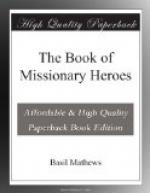“Go up the mast and look ahead,” said Williams to a South Sea Island native. Then he paced the deck, hoping to hear the cry of “Land,” but nothing could the native see.
“Go up again,” cried Williams a little later. And again there was nothing. Four times the man climbed the mast, and four times he reported only sea and sky and cloud. Gradually the sun’s heat had gathered up the great mountains of cloud, and the sky was clear to the edge of the ocean. Then there came a sudden cry from the masthead:
“Teie teie, taua fenua, nei!"[17]
“Here, here is the land we have been seeking.”
All rushed to the bows. As the ship sailed on and they came nearer, they saw a lovely island. Mountains, towering peak on peak, with deep green valleys between brown rocky heights hung with vines, and the great ocean breakers booming in one white line of foaming surf on the reef of living coral, made it look like a vision of fairyland.
They had discovered Rarotonga.
But what of the people of the island?
They were said to be cannibals.
Would they receive the missionaries with clubs and spears? Who would go ashore?
On board the ship were brown South Sea men from the island where John Williams lived. They had burned their idols, and now they too were missionaries of Jesus Christ. Their leader was a fearless young man, Papeiha. He was so daring that once, when everybody else was afraid to go from the ship to a cannibal island, he bound his Bible in his loin cloth, tied them to the top of his head, and swam ashore, defying the sharks, and unafraid of the still more cruel islanders.
So at Rarotonga, when the call came, “Who will go ashore?” and a canoe was let down from the ship’s side, two men, Papeiha and his friend Vahineino,[18] leapt into it. Those two fearlessly paddled towards the shore, which was now one brown stretch of Rarotongans crowded together to see this strange ship with wings that had sailed from over the sea’s edge.
The Rarotongans seemed friendly; so Papeiha and Vahineino, who knew the ways of the water from babyhood and could swim before they could walk, waited for a great Pacific breaker, and then swept in on her foaming crest. The canoe grated on the shore. They walked up the beach under the shade of a grove of trees and said to the Rarotongan king, Makea,[19] and his people:
“We have come to tell you that many of the islands of the sea have burned their idols. Once we in those islands pierced each other with spears and beat each other to death with clubs; we brutally treated our women, and the children taken in war were strung together by their ears like fish on a line. To-day we come—before you have destroyed each other altogether in your wars—to tell you of the great God, our Father, who through His Son Jesus Christ has taught us how to live as brothers.”
King Makea said he was pleased to hear these things, and came in his canoe to the ship to take the other native teachers on shore with him. The ship stood off for the night, for the ocean there is too deep for anchorage.




